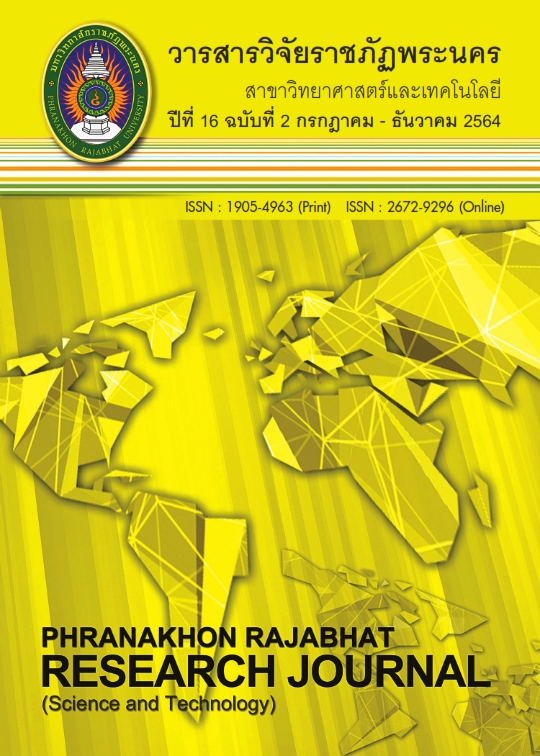NUMERICAL STUDY OF HEAT TRANSFER AND FLUID FLOW IN A CONFINED PLANE TURBULENT JET IMPINGEMENT USING NANOFLUIDS
คำสำคัญ:
impinging jet, heat transfer enhancement, , nanofluidsบทคัดย่อ
This article presents a numerical investigation on heat transfer and fluid flow of a confined plane turbulent nanofluids jet impingement on an isothermal heated surface using single-phase model. The finite volume method and standard k-e turbulent model were used for the solution of resulting governing equations. Al2O3 nanoparticles dispersed in water with volumetric concentration of nanoparticles ranging between 0 and 4% were used as working fluid for simulating the heat transfer and fluid flow of nanofluids jet impingement. At inlet mean velocity profile was non-uniform. The influences of volumetric concentration of nanoparticles, aspect ratio and Reynolds number were examined and discussed in details. The results indicated that the volumetric concentration of nanoparticles, aspect ratio and Reynolds number enhance heat transfer when considering in terms of the local and average Nusselt number, while the skin friction coefficient profile is slightly increased whereas increasing the volumetric concentration of nanoparticles.
เอกสารอ้างอิง
Abdelrehim, O., Khater, A, Mohamad, A.A. & Radwan, A. (2019). Two-phase simulation of nanofluid in a confined single impinging jet. Case Studies in Thermal Engineering, 14, 100423.
Allauddin, U., Mahrukh, M., Rehman, N.U., Haque, M. E. & Uddin, N. (2018). Numerical investigation of heat transfer by an impinging jet using alumina–water nanofluid. Numerical Heat Transfer A, 74(8), 1486-1502.
Ashforth-Frost, S., Jambunathan, K. & Whitney, C.F. (1997). Velocity and turbulence characteristics of a semiconfined orthogonally impinging slot jet. Experimental Thermal and Fluid Science, 14, 60–67.
Choi, S.U.S. & Eastman, J.A. (1995). Enhancing thermal conductivity of fluids with nanoparticles. ASME International Mechanical Engineering Congress and Exposition, 66, 99–105.
Chon, C.H., Kihm, K.D., Lee, S.P. & Choi, S.U. (2005). Empirical correlation finding the role of temperature and particle size for nanofluid (Al2O3) thermal conductivity enhancement. Applied Physics Letters, 87, 153107-3.
Ferrari, J.,Lior, N. & Slycke, J. (2003). An evaluation of gas quenching of steel rings by multiple-jet impingement. Journal of Materials Processing Technology, 136, 190–201.
Kubacki, S. & E. Dick, E. (2010). Simulation of plane impinging jets with k– based hybrid RANS/LES models. International Journal of Heat and Fluid Flow, 31, 862–878.
Launder, B.E. & Spalding, D.B. (1974). The numerical computation of turbulent flows. Computer Methods in Applied Mechanics and Engineering, 3, 269-289.
Manca, O., Mesolella, P., Nardini, S. & Ricci, D. (2011). Numerical study of a confined slot impinging jet with nanofluids. Nanoscale Research Letters, 6:188.
Manca, O., Ricci, D., Nardini, S. & Lorenzo, G.D. (2016). Thermal and fluid dynamic behaviors of confined laminar impinging slot jets with nanofluids. International Communications in Heat and Mass Transfer, 70, 15–26.
Masoumi, N., Sohrabi, N. & Behzadmehr, A. (2009). A new model for calculating the effective viscosity of nanofluids. Journal of Physics D: Applied Physics, 42, 0550‐501.
Mookherjee, O., Pramanik, S. & Kar, U.K. (2020). Numerical investigation of a confined laminar jet impingement cooling of heat sources using nanofluids. ASME Journal of Heat Transfer, 142(8), 082301.
Patankar, S.V. (1980). Numerical Heat Transfer and Fluid Flow. New York: Hemisphere Publishing Corporation.
Peng, W., Jizu, L., Minli, B., Yuyan, W. & Chengzhi, H. (2014). A numerical investigation of impinging jet cooling with nanofluids. Nanoscale and Microscale Thermophysical Engineering, 18, 329–353.
Rohsenow, W.M., Hartnett, J.P. & Cho, Y.I. (1998). Handbook of Heat Transfer. 3rd Edition. New York: McGraw-Hill.
Roy, G., Nguyen, C.T. & Lajoie, P.R. (2004). Numerical investigation of laminar flow and heat transfer in a radial flow cooling system with the use of nanofluids. Superlattices and Microstructures, 35, 497–511.
Selvakumar, P. & Suresh, S. (2012). Convective performance of CuO/water nanofluid in an electronic heat sink. Experimental Thermal and Fluid Science, 40, 57–63.
Tsubokura, M., Kobayashi, T., Taniguchi, N. & Jones, W.P. (2003) A numerical study on the eddy structures of impinging jets exited at the inlet. International Journal of Heat and Fluid Flow, 24, 500–511.
Venkitaraj, K.P., Suresh S., Alwin Mathew, T., Bibin B.S. & Abraham, J. (2018). An experimental investigation on heat transfer enhancement in the laminar flow of water/TiO2 nanofluid through a tube heat exchanger fitted with modified butterfly inserts. Heat and Mass Transfer, 54, 813–829.
Zuckerman, N. & Lior, N. (2006). Jet impingement heat transfer: physics, correlations, and numerical modeling. Advances in Heat Transfer, 39, 565–631.
ดาวน์โหลด
เผยแพร่แล้ว
ฉบับ
ประเภทบทความ
สัญญาอนุญาต
โปรดกรอกเอกสารและลงนาม "หนังสือรับรองให้ตีพิมพ์บทความในวารสารวิจัยมหาวิทยาลัยราชภัฏพระนคร สาขาวิทยาศาสตร์และเทคโนโลยี" ก่อนการตีพิมพ์




